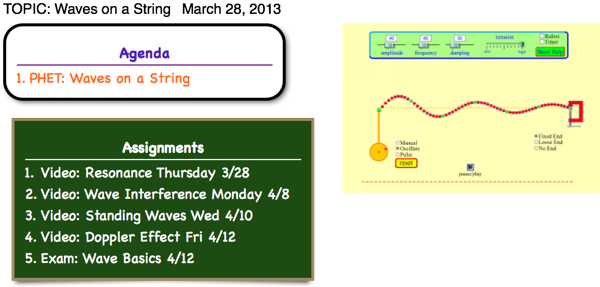
Tag Archives: standing waves
Wave Phenomena WS Solutions

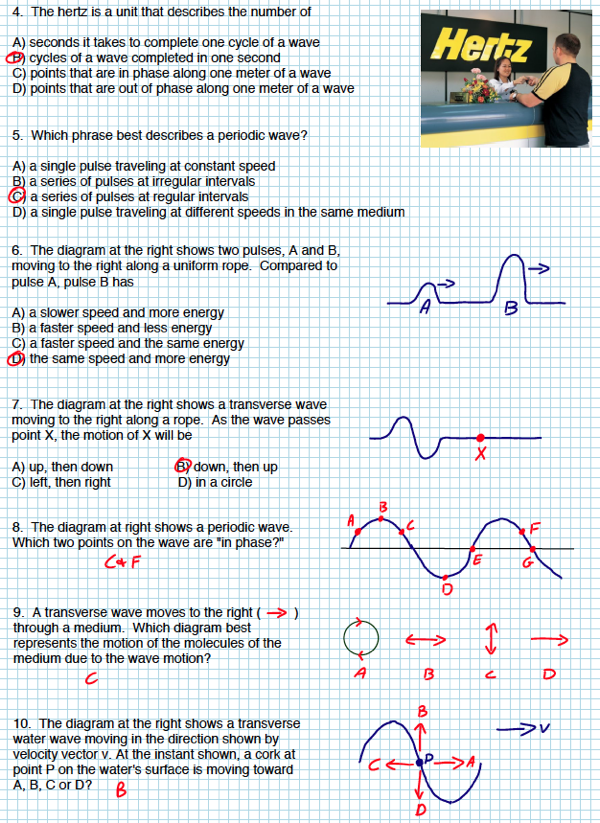
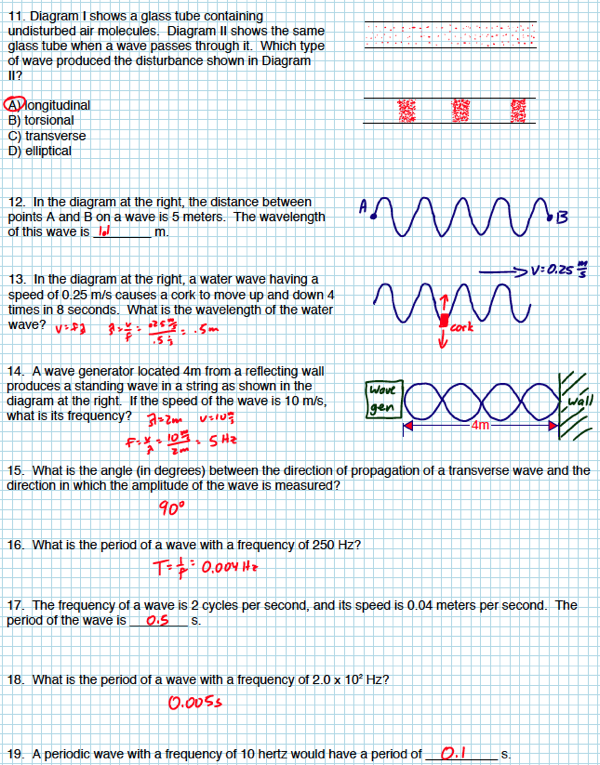
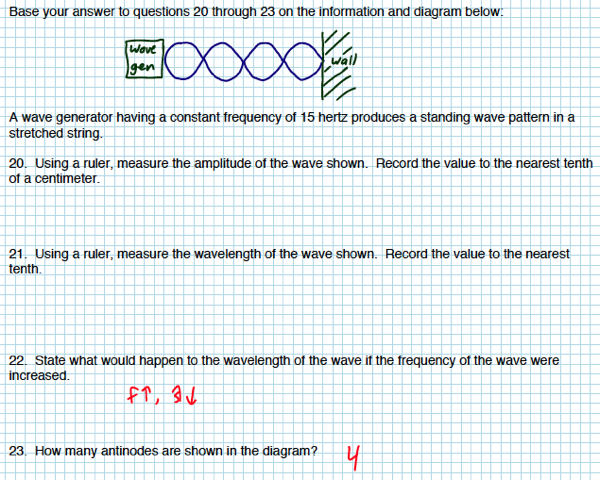
Wave Phenomena
Superposition
When more than one wave travels through the same location in the same medium at the same time, the total displacement of the medium is governed by the principle of superposition. The principle of superposition simply states that the total displacement is the sum of all the individual displacements of the waves. The combined effect of the interaction of the multiple waves is known as wave interference.

Question: The diagram shows two pulses approaching each other in a uniform medium. Diagram the superposition of the two pulses.
Answer:
Constructive Interference
When two or more pulses with displacements in the same direction interact, the effect is known as constructive interference. The resulting displacement is greater than the original individual pulses. Once the pulses have passed by each other, they continue along their original path in their original shape, as if they had never met. An animation of two pulses interfering constructively is shown at the site below: Courtesy Penn State Schuylkill
Notice the top pulse travels to the right with a positive displacement, while the middle pulse travels to the left with a positive displacement. When the two pulses meet (shown at bottom), the interfere constructively before continuing on their path as if they had never met.
Destructive Interference
When two or more pulses with displacements in opposite directions interact, the effect is known as destructive interference. The resulting displacements negate each other. Once the pulses have passed by each other, they continue along their original path in their original shape, as if they had never met. An animation of two pulses interfering destructively is shown at the site below: Courtesy Penn State Schuylkill
Notice the top pulse travels to the right with a positive displacement, while the middle pulse travels to the left with a negative displacement. When the two pulses meet (shown at bottom), the interfere destructively before continuing on their path as if they had never met.
Question: Two wave sources operating in phase in the same medium produce the circular wave patterns shown in the diagram. The solid lines represent wave crests and the dashed lines represent wave troughs. Which point is at a position of maximum destructive interference?
Answer: Point B is at a position of maximum destructive interference, since point B represents the intersection of a crest and a trough.
Standing Waves
When waves of the same frequency and amplitude traveling in opposite directions meet, a standing wave is produced. A standing wave is a wave in which certain points (nodes) appear to be standing still and other points (anti-nodes) vibrate with maximum amplitude above and below the axis.
Looking at the standing wave produced on the right, we can see a total of five nodes in the wave, and four anti-nodes. For any standing wave pattern, you will always have one more node than anti-node.
Standing waves can be observed in a variety of patterns and configurations, and are responsible for the functioning of most musical instruments. Guitar strings, for example, demonstrate a standing wave pattern. By fretting the strings, you adjust the wavelength of the string, and therefore the frequency of the standing wave pattern, creating a different pitch. Similar functionality is seen in instruments ranging from pianos and drums to flutes, harps, trombones, xylophones, and even pipe organs!
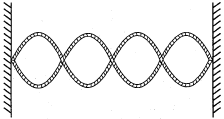
Question: The diagram shows a standing wave in a string clamped at each end. What is the total number of nodes and antinodes in the standing wave?
Answer: Five nodes and four anti-nodes.
Due to their very nature, waves exhibit a number of behaviors that may not be obvious upon first inspection, including the Doppler Effect, reflection, refraction, and diffraction. Understanding these behaviors brings us closer to understanding the universe, while also providing a number of useful applications including, but not limited to, radar, sonography, digital televisions, mirrors, telescopes, glasses, contact lenses, atomic research, and even holography!
Doppler Effect
The shift in a wave’s observed frequency due to relative motion between the source of the wave and the observer is known as the Doppler Effect. In essence, when the source and/or observer are moving toward each other, the observer perceives a shift to a higher frequency, and when the source and/or observer are moving away from each other, the observer perceives a lower frequency.
This can be observed when a vehicle travels past you. As you hear the vehicle approach, you can observe a higher frequency noise, and as the vehicle passes by you and then moves away, you observe a lower frequency noise.
The Doppler Effect results from waves having a fixed speed in a given medium. As waves are emitted, a moving source or observer encounters the wave fronts at a different frequency than they waves are emitted, resulting in a perceived shift in frequency.
Question: A car’s horn is producing a sound wave having a constant frequency of 350 hertz. If the car moves toward a stationary observer at constant speed, the frequency of the car’s horn detected by this observer may be:
- 320 Hz
- 330 Hz
- 350 Hz
- 380 Hz
Answer: If source is moving toward stationary observer, observed frequency must be higher than source frequency, therefore the correct answer is (4) 380 Hz.
 An exciting application of the Doppler Effect involves the analysis of radiation from distant stars and galaxies in the universe. Based on the basic elements that compose stars, we know what frequencies of radiation to look for. However, when analyzing these objects, we observe frequencies shifted toward the red end of the electromagnetic spectrum (lower frequencies), known as the Red Shift. This indicates that these celestial objects must be moving away from us. The more distant the object, the greater the red shift. Putting this together, we can conclude that more distant celestial objects are moving away from us faster, and therefore, the universe as we know it must be expanding!
An exciting application of the Doppler Effect involves the analysis of radiation from distant stars and galaxies in the universe. Based on the basic elements that compose stars, we know what frequencies of radiation to look for. However, when analyzing these objects, we observe frequencies shifted toward the red end of the electromagnetic spectrum (lower frequencies), known as the Red Shift. This indicates that these celestial objects must be moving away from us. The more distant the object, the greater the red shift. Putting this together, we can conclude that more distant celestial objects are moving away from us faster, and therefore, the universe as we know it must be expanding!
Honda Road Music
Wave Interference
Superposition
When more than one wave travels through the same location in the same medium at the same time, the total displacement of the medium is governed by the principle of superposition. The principle of superposition simply states that the total displacement is the sum of all the individual displacements of the waves. The combined effect of the interaction of the multiple waves is known as wave interference.

Question: The diagram shows two pulses approaching each other in a uniform medium. Diagram the superposition of the two pulses.
Answer:
Constructive Interference
When two or more pulses with displacements in the same direction interact, the effect is known as constructive interference. The resulting displacement is greater than the original individual pulses. Once the pulses have passed by each other, they continue along their original path in their original shape, as if they had never met. An animation of two pulses can be viewed here. Notice the top pulse travels to the right with a positive displacement, while the middle pulse travels to the left with a positive displacement. When the two pulses meet (shown at bottom), the interfere constructively before continuing on their path as if they had never met.
Destructive Interference
When two or more pulses with displacements in opposite directions interact, the effect is known as destructive interference. The resulting displacements negate each other. Once the pulses have passed by each other, they continue along their original path in their original shape, as if they had never met. An animation of two pulses interfering destructively is shown here.
Notice the top pulse travels to the right with a positive displacement, while the middle pulse travels to the left with a negative displacement. When the two pulses meet (shown at bottom), the interfere destructively before continuing on their path as if they had never met.
Question: Two wave sources operating in phase in the same medium produce the circular wave patterns shown in the diagram. The solid lines represent wave crests and the dashed lines represent wave troughs. Which point is at a position of maximum destructive interference?
Answer: Point B is at a position of maximum destructive interference, since point B represents the intersection of a crest and a trough.
Standing Waves
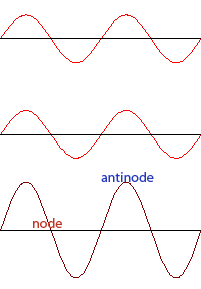
When waves of the same frequency and amplitude traveling in opposite directions meet, a standing wave is produced. A standing wave is a wave in which certain points (nodes) appear to be standing still and other points (anti-nodes) vibrate with maximum amplitude above and below the axis.
Looking at the standing wave produced on the right, we can see a total of five nodes in the wave, and four anti-nodes. For any standing wave pattern, you will always have one more node than anti-node.
Standing waves can be observed in a variety of patterns and configurations, and are responsible for the functioning of most musical instruments. Guitar strings, for example, demonstrate a standing wave pattern. By fretting the strings, you adjust the wavelength of the string, and therefore the frequency of the standing wave pattern, creating a different pitch. Similar functionality is seen in instruments ranging from pianos and drums to flutes, harps, trombones, xylophones, and even pipe organs!
Question: The diagram shows a standing wave in a string clamped at each end. What is the total number of nodes and antinodes in the standing wave?
Answer: Five nodes and four anti-nodes.







